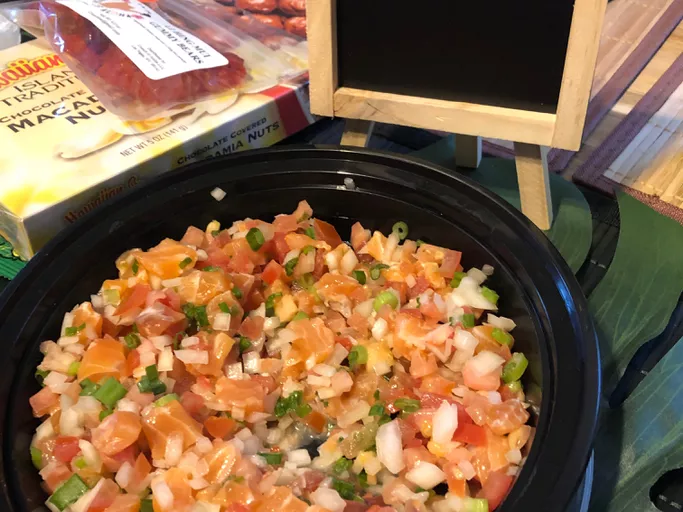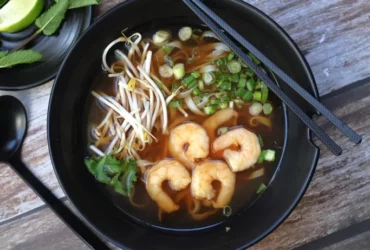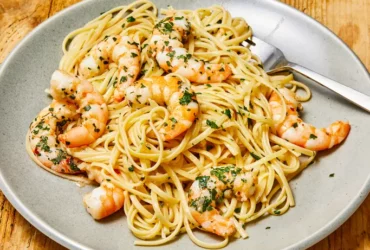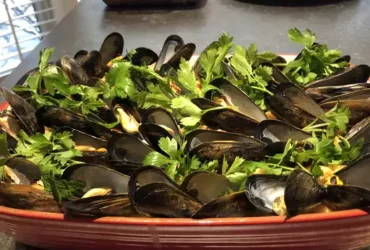Ingredients
Kona Sea Salt or Hawaiian Red Salt (preferably harvested from Hawaiian volcanic ash)
Kona sea salt, also known as Hawaiian red salt, is a type of specialty salt that is harvested from the shores of Hawaii.
It is prized for its unique flavor and texture, which are said to be distinct from other types of salt.
The distinctive color of Kona sea salt comes from the volcanic ash deposits in the region, which impart a reddish-brown hue to the crystals.
When it comes to using Kona sea salt or Hawaiian red salt in cooking, there are several factors to consider:
- The type of dish being prepared
- The desired flavor profile
- Any dietary restrictions or preferences (e.g. low-sodium, gluten-free)
- The freshness and quality of the salt
In a recipe such as Lomi Lomi Salmon, where the goal is to balance salty and sweet flavors, Kona sea salt or Hawaiian red salt can be used in small quantities to enhance the overall flavor without overpowering it.
Some benefits of using Kona sea salt or Hawaiian red salt include:
- Adds a distinctive, slightly sweet flavor
- Possesses a coarser texture that can help to balance flavors
- Can be used as a finishing salt in some recipes
However, it’s worth noting that some people may prefer to use regular table salt or other types of salt depending on their individual tastes and needs.
In general, when working with Kona sea salt or Hawaiian red salt, it’s best to use a light hand and to taste as you go, adjusting the amount of salt to suit your personal preferences.
Salt-free seasoning blend or alternative salt, such as Himalayan pink salt or sea salt
The key to a delicious _Lomi Lomi Salmon_ recipe lies not only in its simplicity but also in the quality of its ingredients. In this recipe, we’ll be using a combination of salt-free seasoning blends and alternative salts to add depth and flavor to the dish.
When it comes to salt-free seasoning blends, there are numerous options available on the market, each with their own unique blend of herbs and spices. Some popular brands include _Mrs. Dash_ or Spice Island, which can be found in most local grocery stores or online.
An alternative to traditional salt is using Himalayan pink salt or sea salt. Both options offer a lower sodium content compared to table salt, making them ideal for those on a low-sodium diet. _Himalayan pink salt_ is mined from the Khewra Salt Mines in the Punjab region of Pakistan and has been prized for its unique color and flavor.
For this recipe, we recommend using _Kosher salt_, which has a coarser texture than table salt and is less likely to over-salt your dish. However, if you’re looking for a lower-sodium option, sea salt or Himalayan pink salt can be used in its place.
Other key ingredients in the Lomi Lomi Salmon recipe include fresh salmon, diced tomatoes, green onions, and chopped macadamia nuts. These ingredients work together to create a flavorful and refreshing dish that’s perfect for any occasion.
When using alternative salts, it’s essential to note that some may have a stronger flavor profile than others. _Himalayan pink salt_, for example, has a slightly sweet and mineral-rich flavor, while sea salt is often described as having a more delicate, oceanic taste.
In terms of ratios, we recommend using about 1/4 teaspoon of _salt-free seasoning blend_ or alternative salt per pound of salmon. This will allow the flavors to meld together without overpowering the dish.
Instructions
Combine salmon and salt in a bowl, massaging the salt into the fish to break down proteins and tenderize it.
Culinary preparation for Lomi Lomi Salmon begins with a crucial step of combining salmon and salt in a bowl, requiring care and patience to achieve optimal results.
The first step involves _selecting the right type of fish_, preferably fresh and sashimi-grade Atlantic or Pacific salmon. This choice is critical as it affects the flavor, texture, and overall quality of the final product.
Once the salmon has been obtained, cut the fish into smaller pieces, about 1-2 inches in size, to facilitate even seasoning and tenderization.
The next step is to create a _salt paste_ by mixing kosher salt, also known as halite, with water or ice to form a brine. This mixture should be prepared in accordance with the recipe’s requirements, typically about 2-3 tablespoons of salt for every 1 cup of ice or water.
The prepared salmon pieces are then added to the bowl containing the salt paste, requiring a gentle yet firm pressure to distribute the seasoning evenly. It is essential to use your fingers to _massage the salt into the fish_ in order to break down the proteins and tenderize it.
This process, known as osmosis, helps to infuse the salmon with flavor while simultaneously tenderizing its texture. The goal is to achieve a uniform seasoning that complements the natural flavors of the fish without overpowering it.
Incorporate chopped green onions, diced fresh tomatoes, and chopped cilantro, ensuring an even distribution of flavors.
To create a delicious Lomi Lomi Salmon, it’s crucial to pay close attention to the instructions and ensure an even distribution of flavors. This classic Hawaiian dish combines the richness of salmon with the freshness of local ingredients, making it a staple at many luaus and gatherings.
The first step in preparing this recipe is to gather all the necessary ingredients. You’ll need one pound of salt-cured salmon, which can be found at most Asian or Hawaiian markets. In addition to the salmon, you’ll also need the following:
- 1/2 cup of chopped green onions, which add a pungent flavor and crunchy texture
- 1/2 cup of diced fresh tomatoes, a must-have for any Hawaiian dish
- 1 tablespoon of chopped cilantro, which provides a burst of freshness and aroma
- 1 tablespoon of soy sauce, a staple in many Asian dishes
- 1 tablespoon of sugar, to balance out the savory flavors
- 1 teaspoon of grated ginger, a root that’s often used in Hawaiian cooking
- 1/4 cup of chopped Maui onions, which add a sweet and pungent flavor
Once you have all the ingredients ready, it’s time to start preparing the dish. Begin by chopping the green onions, fresh tomatoes, and cilantro into fine pieces, making sure they’re evenly distributed throughout the mixture.
In a large bowl, combine the chopped ingredients with the soy sauce, sugar, grated ginger, and Maui onions. Mix well until all the flavors are evenly incorporated.
Add the salt-cured salmon to the bowl and mix gently, being careful not to break up the fish. The goal is to create a harmonious balance of flavors, rather than a uniform texture.
Once everything is well combined, it’s time to refrigerate the Lomi Lomi Salmon for at least 30 minutes to allow all the flavors to meld together. After chilling, serve the dish at room temperature or chilled, garnished with additional chopped cilantro and green onions if desired.
This delicious recipe is perfect for any occasion, whether you’re hosting a Hawaiian-themed party or simply want to add some excitement to your weekly dinner routine. With its bold flavors and fresh ingredients, Lomi Lomi Salmon is sure to become a new favorite in no time!
Preparation and Serving
Mix Lomi Salmon gently, allowing ingredients to meld together without over-mixing or compacting the mixture.
Making a delicious and authentic Hawaiian dish like Lomi Salmon requires attention to detail and gentle handling when it comes to mixing its key ingredients. The traditional recipe for Lomi Lomi Salmon typically consists of salmon, salt, chopped green onions (such as Maui onions or scallions), diced tomatoes (often made from fresh tomatoes, salted, and let to sit until they release their juices and become almost dry), chopped chili peppers or hot sauce, and limu seaweed.
Before mixing the ingredients, ensure that all of them are prepared separately and ready for assembly. The salmon should be cut into small pieces or flakes, allowing it to easily integrate with other ingredients in the mixture. It’s also advisable to have a large bowl on hand for combining the components.
To begin the preparation process, gently combine the salmon in the bowl with salt (preferably Hawaiian sea salt), ensuring an even distribution of the seasoning without over-salting or compacting the fish. After this step is completed, add the chopped green onions to the mixture and stir them into the salmon until they are evenly distributed.
Next, add the diced tomatoes, which should be dry from having been left to sit, allowing their juices to evaporate. Stir these gently into the bowl, taking care not to over-mix or compact the mixture further. This step helps ensure that the lomi texture remains distinct and not overly dense.
Once the tomato has been integrated with the other ingredients, add the chopped chili peppers or hot sauce to the bowl. Be cautious when introducing heat into your dish, as it may be more than what some palates are accustomed to. Stir these final components into the mixture until they’re evenly distributed across all of the other ingredients.
Finally, gently stir in the limu seaweed at this stage, being mindful not to over-mix or compact the entire mixture any further. It’s essential that all ingredients meld together without losing their distinct textures and flavors.
Serve chilled or at room temperature, garnished with additional green onions or a sprinkle of Hawaiian Red Salt for added visual appeal and flavor enhancement.
To prepare and serve Lomi Lomi Salmon, it’s essential to pay attention to the temperature at which you serve this popular Hawaiian side dish. While some may prefer their Lomi Lomi Salmon chilled, others enjoy it at room temperature.
Serving it chilled allows for a refreshing contrast between the cool, diced salmon and the tangy flavor of the lomi tomatoes, onions, and salt. This is particularly well-suited to outdoor gatherings or barbecues where guests are looking for something light and easy to eat.
On the other hand, serving Lomi Lomi Salmon at room temperature brings out a different dynamic in terms of texture and flavor. The slightly warmed ingredients meld together more harmoniously, and the subtle sweetness of the tomatoes becomes more apparent.
In either case, garnishing with additional green onions or a sprinkle of Hawaiian Red Salt adds an extra layer of visual appeal and flavor enhancement to this beloved dish.
The green onions provide a pop of color and a fresh flavor that complements the rich taste of the salmon. Meanwhile, the Hawaiian Red Salt – which has its roots in traditional Hawaiian salt-making practices – lends a subtle smokiness that elevates the overall depth of flavors in Lomi Lomi Salmon.
- Best LeadsGorilla Alternatives for 2025 - April 22, 2025
- Best Leadzai Alternatives for 2025 - April 22, 2025
- Best LeadSwift Alternatives for 2025 - April 21, 2025















